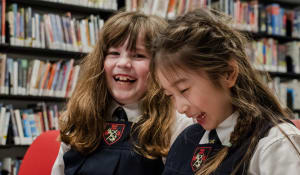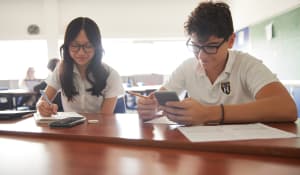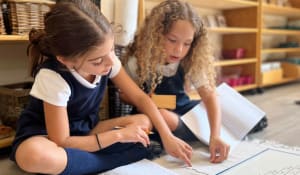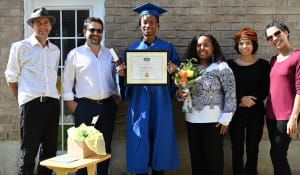
Teachers with musical talents have a special opportunity to strengthen the literacy skills being taught in the classroom. PHOTO COURTESY OF ST. MICHAELS UNIVERSITY SCHOOL
In February 2012, the long-awaited Balanced Literacy Diet was released. After many years of hard work, Dr. Dale Willows from the Ontario Institute for Studies in Education (OISE) and her team released The Balanced Literacy Diet website making hundreds of research-based, model lessons in literacy available for educators and parents around the world. The Balanced Literacy Diet is a framework for understanding and teaching literacy, based upon 15 essential literacy "food groups" including:
- Motivation for Literacy
- Oral Language
- Knowledge Building
- Concepts of Print
- Writing Conventions
- Phonemic Awareness
- Letter-Sounds & Phonics
- Spelling & Word Study
- Vocabulary
- Reading Fluency & Expression
- Reading Comprehension
- Writing Processes & Strategies
- Text Structure & Genres
- Classroom Organization
- Assessment
As educators, we know that as students develop, the emphasis we place on these literacy components changes from teaching the foundations of literacy, including conventions and phonemic awareness to using literacy for learning and expressing oneself. The Balanced Literacy Diet website has an easy-to-follow section on the stages of literacy development, explaining which skills should be emphasized as students progress through their development in literacy.
Literacy Through Music
A study by Cunningham and Allington in 2011, shows that when we see or hear words in a new context, our brain creates new synapses (connections) to those words, making it so crucial that children are exposed to vocabulary and other literacy skills in different and meaningful ways. Music has been one of the most effective tools in bringing meaning to new material including skills in literacy–tapping into the diet component, Motivation for Literacy. There are many programs available to make teaching literacy through music accessible for the everyday teacher, some of which include: Sing, Spell, Read, and Write from Sue Dickson; I'm All Ears: Sing Into Reading from Fran Avni; and Literacy-Building Songs from the Bureau of Education and Research.
Teachers with musical talents have a special opportunity to strengthen literacy skills being taught in the classroom, and create further connections to what is being learned (increasing synapses in the brain).
Here are five easy ways schools can implement music education to improve literacy and learning:
1. Have your music teachers collaborate with homeroom teachers
If you are working on rhyming in the classroom, ask the music teacher if he/she knows of any music activities that they can engage the class in, to promote students' rhyming skills. Songs such as, Down by the Bay, and Willoughby Wallaby Woo by Raffi are fun and effective options.
2. Take advantage of how your music program lends itself to literacy instruction
Music programs running under the Orff Approach are great for enhancing literacy; using syllables, rhyming, music, movement, dance, drama and language are part of the foundation of this approach to teaching and learning music. The use of Orff instruments are included: These are pitched, and non-pitched percussion instruments, such as bongos (non-pitched), triangles (non-pitched), glockenspiels (pitched), xylophones (pitched), etc. If your school's music program runs off of the Kodály approach, the use of syllables to represent various note values as well as call and response activities will enhance letter-sound correspondence and phonemic awareness. (Call and response activities involve the teacher, or a group of students speaking or singing a phrase, while the other students repeat a response, which could be the same phrase or a phrase differing in its words, sound, or in its entirety.) The Kodaly method of teaching music originated in Hungary with a focus on sight singing and playing instruments from memory. Children learn to read music through interval training, using what is referred to as the "movable do." (Read more about music approaches used in the classroom.)
3. Get your students involved in composition
It is never too early to have your students compose a piece of music. In fact, the Orff Approach lends itself quite well to this activity. Younger students can contribute words to a specified quarter or whole note rhythm as a class, while older students can work in small groups, providing words to a more complicated rhythm using half and eighth notes, requiring more advanced manipulation of words, syllables, and phonemes, such as adding morphemes to a word to make it fit within a phrase.
4. Use a popular song as a platform for expressive writing
Using a popular song which illustrates a world or relatable issue, such as Waving Flag, by K'naan, can be an effective motivator for students to write about how the style of music matches the message of the piece, or a response to the piece–in this case, how it made them feel, or what they interpreted the message of the song to be. Using a song such as, If I Had A Million Dollars, by Barenaked Ladies opens up doors for writing pieces on how students would use the money to help the world, or even to express their own desires.
5. Use song books to teach concepts of print and word study
Song books allow children to sing their favourite songs while using their finger to follow along in the book. As words are often repeated in songs, here, they are repeated in print, allowing students to familiarize themselves with new vocabulary. Pictures allow for differentiated learning, allowing students to follow along using pictures as their key to turn the page. Two excellent books I have used with my students are, Over the Rainbow and Puff the Magic Dragon, both beautifully illustrated by Eric Puybaret.
Remember, literacy instruction should be meaningful. If music is being used to teach or enhance a "food group" of literacy, make sure you have a specific goal in mind as you create your integrative lesson. Allow your students to have fun and fully engage in whatever is being taught, whether it is the life cycle of a butterfly, or something as simple as the sound, "/t/."
[For more suggestions on how you can use music to enhance literacy instruction, contact Michelle Eisen at: FeedingTheNeedToSucceed@gmail.com]






















